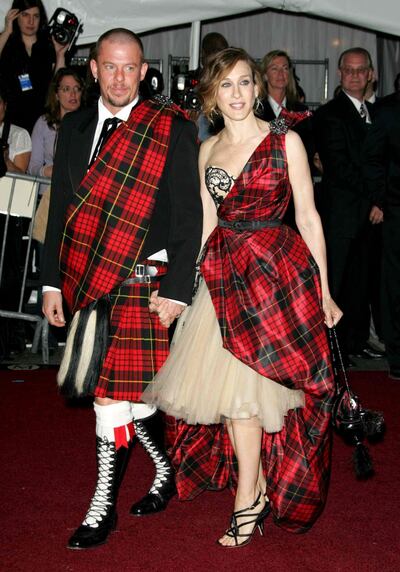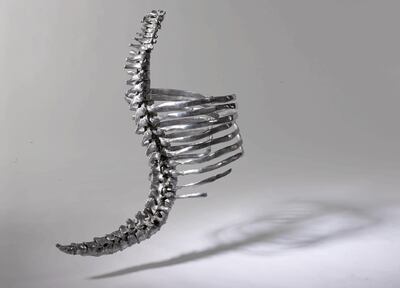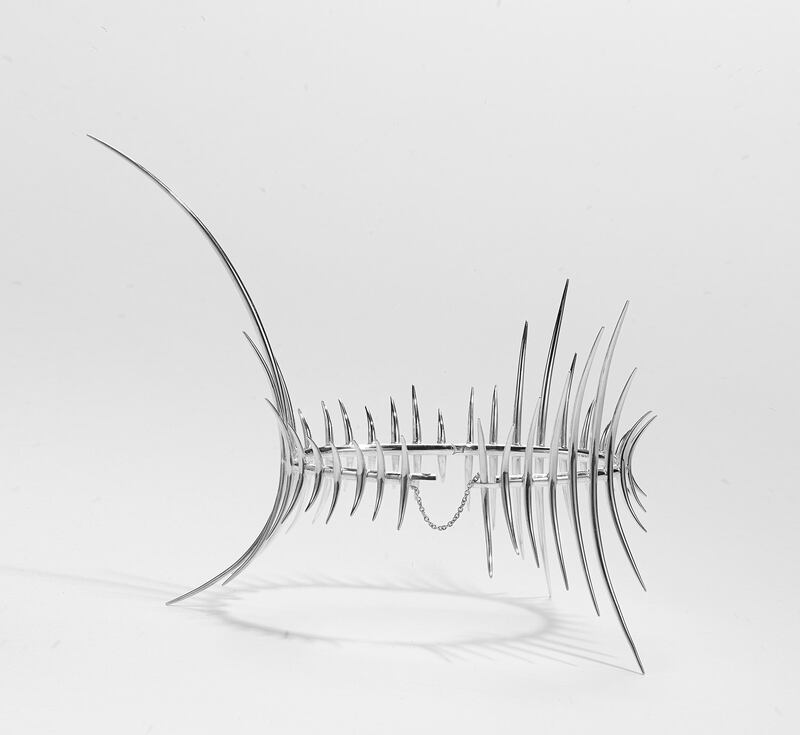If you were one of the 1.2 million people who visited the Alexander McQueen: Savage Beauty exhibition during its sell-out runs in London and New York, you will have seen – perhaps unknowingly – the work of Shaun Leane.
A close friend and long-time collaborator of McQueen, Leane worked alongside him on every fashion show from 1996 to 2010. As a trained jeweller, it was Leane who created bespoke pieces of adornment for the runway, helping to bring the fashion designer’s vision of twisted, gothic splendour to life.
Now, for the first time, Leane is auctioning more than 45 pieces from his own collection. The sale, entitled Couture Fashion Jewellery – The Personal Archive of Shaun Leane, is being held in conjunction with Sotheby's in New York on December 4, with prices ranging from US$2,000 to $400,000 (Dh7,346 to Dh1.5 million).
With this sale comes the unique opportunity, from November 30, to get an up-close look at the craftsmanship of the pieces that have graced runways, fashion magazines and the arms and necks of figures such as Isabella Blow, Sarah Jessica Parker, Kate Moss and "The Honourable" Daphne Guinness. For any historian of fashion, these jewellery pieces are truly deserving of the accolade "iconic", coming as they do from a unique period in British fashion history, where creativity was inextricably wedded to impeccable execution, from the cut of the clothes, to the precise curve of the jewellery.
In a unique partnership, Leane and McQueen, with Sarah Burton, worked side by side for 17 years, each helping to push the others to achieve more. It started in 1992, when Leane met the then young fashion student born Lee McQueen, who was doing his master's in fashion design at Central Saint Martins. At the time, Leane was working as a high-end jeweller – having served an apprenticeship as a goldsmith, before progressing to making tiaras and necklaces for the royal heads of Europe.

Joined by a shared attention to detail and having started work young (both at 16, Leane as an apprentice, McQueen in Saville Row), the two struck up a bond. The following year, when McQueen graduated, he visited Leane in his studio, and asked him to make some pieces for his fashion show. Confronted by McQueen's uncompromising vision, Leane found himself far outside his comfort zone. Used to working in precious metals and diamonds for monied clients, Leane was instead tasked with producing avant-garde designs for free.
Lacking funds to buy the gold Leane was used to working in, McQueen suggested he find alternative materials. From this sprang Leane's experimentation with brass, silver and aluminium, which were cast, cut, moulded and soldered. The resulting headpieces, jewellery and body pieces were a total reimagining of jewellery, what it represented and how it interacted with the body.
McQueen described Leane as “a close friend and companion for many years. He captures the feeling of my work and the aesthetic of the time we live in … full of structure and finesse, crafted to perfection”.
In turn, Leane declared to Dezeen magazine in 2015 that "Alexander McQueen changed fashion and I changed jewellery".
Their first collaboration was for McQueen's Hunger spring/summer 1996 show. Leane created the Tusk Earring, comprising a single, elegant curve from the ear – a shape he would reference many times. For McQueen's Overlook autumn/winter 1999 show, Leane created the Coiled Corset, a sculptural body piece of bands of aluminium wrapped around the female torso. Encasing sensual curves in rigid metal, it stretched from jaw to hip, sealing the wearer inside a rigid sarcophagus that was fastened closed with screws. Seemingly light and airy, it carried all the contradictions McQueen was drawn to, and his obsession with the underbelly of life. Leane has included this piece as part of Sotheby's sale, and it is engraved with the date and names of both designers. It has an estimate sale price of between $250,000 and $350,000.
Another piece in the sale is Skeleton from the Untitled spring/summer 1998 collection. Leane constructed this as a skeletal, metallic spine, casting it from aluminium; its ribs encase the body, while the vertebrae continue down and swing out as a tail. Featured on the runway, in American Vogue and the touring exhibition, the body piece also has an estimated sale price of between $250,000 and $350,000.

Impressed by his work with McQueen, stylist Blow asked Leane to create a piece that encapsulated his aesthetic. As the woman who discovered McQueen, Blow is known to have a keen eye for talent, and she encouraged Leane to blend traditional jewellery techniques with creativity. The resulting Tusk Anklet in silver, made in 1997, has a reserve price of between $10,000 and $15,000.
In keeping with McQueen's recurring themes of beauty and aggression, Leane also began working with fashion doyenne Guinness on a bespoke metallic glove. Muse to John Galliano and then Karl Lagerfeld, Guinness has been intrinsically linked to the world of fashion for many years, so when she asked Leane to create her a piece, he agreed. Taking more than five years to complete, the Contra Mundum evening glove (Latin for "against the world") is an armour-inspired arm piece, set with about 5,000 pavé white diamonds shaped into birds, on chain mail made from a thousand grams of 18K white gold. It extends almost to the elbow, and features silver-clawed fingertips, inlaid with diamond nails.
_________________
Read more:
[ A global guide to 2017’s best fashion exhibitions ]
[ Alexander McQueen’s Box Bag draws inspiration from antique luggage cases ]
[ From Vuitton to Dior: a history of art collaborating with fashion ]
_________________
Also included in the sale is the Crown of Thorns, a headpiece from the Dante autumn/winter 1996 collection. A coil of spiked metal that wraps around the head, it is estimated to sell for between $40,000 and $60,000. A matching arm piece, which snakes up the arm and appears to piece the ear, is estimated at between $30,000 and $50,000.
It is fair to say that this is not just a body of work going under the hammer; rather, it is perhaps a way to pay tribute to the man Leane described as his mentor. “I believe that the collection represents a level of creative freedom that has no parallel today,” Leane says, “and a time when jewellery, performance art and fashion fused as one. I see the auction as answering the questions these objects put forward when I began creating them: is it art? Is it fashion? Is it jewellery? Its destiny now is to do the job it was designed to do: to inspire and provoke.”





